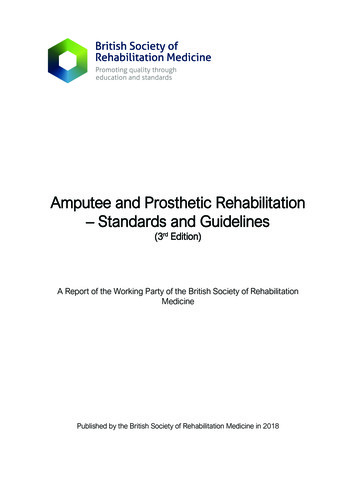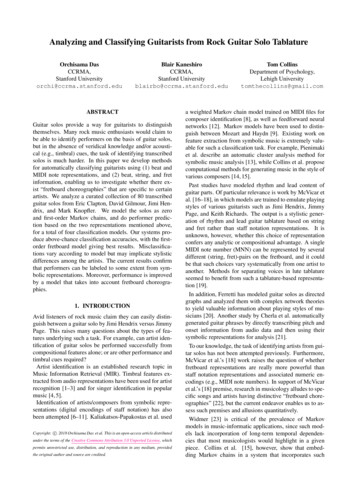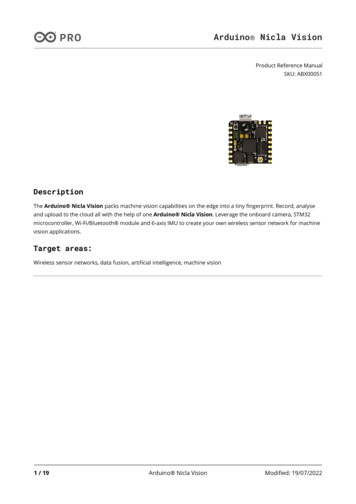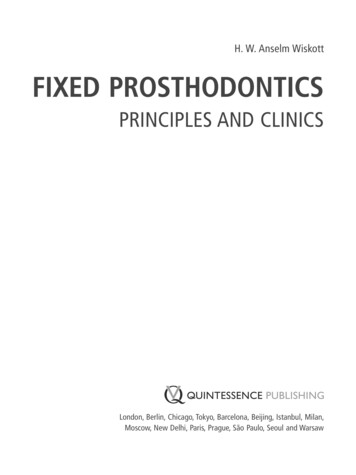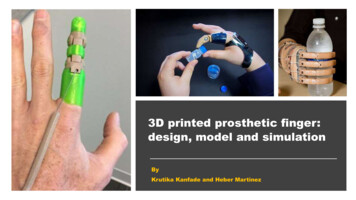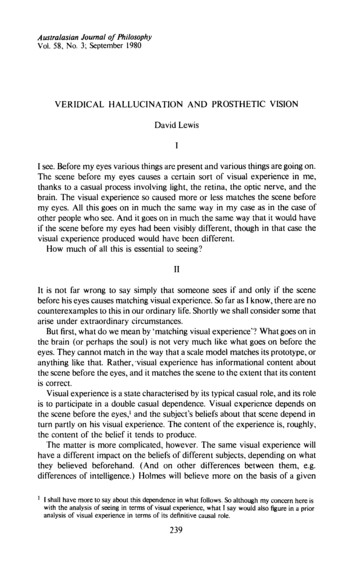
Transcription
Australasian Journal of PhilosophyVol. 58, No. 3; September 1980V E R I D I C A L H A L L U C I N A T I O N A N D P R O S T H E T I C VISIONDownloaded by [Yale University Library] at 09:58 04 June 2013David LewisI see. Before m y eyes various things are present and various things are going on.The scene before my eyes causes a certain sort o f visual experience in me,thanks to a casual process involving light, the retina, the optic nerve, and thebrain. The visual experience so caused more or less matches the scene beforemy eyes. All this goes on in much the same way in my case as in the case ofother people who see. A n d it goes on in much the same way that it would haveif the scene before my eyes had been visibly different, though in that case thevisual experience produced would have been different.How much o f all this is essential to seeing?IIIt is not far wrong to say simply that someone sees if and only if the scenebefore his eyes causes matching visual experience. So far as I know, there are nocounterexamples to this in our ordinary life. Shortly we shall consider some thatarise under extraordinary circumstances.But first, what do we mean by 'matching visual experience'? What goes on inthe brain (or perhaps the soul) is not very much like what goes on before theeyes. They cannot match in the way that a scale model matches its prototype, oranything like that. Rather, "visual experience has informational content aboutthe scene before the eyes, and it matches the scene to the extent that its contentis correct.Visual experience is a state characterised by its typical casual role, and its roleis to participate in a double casual dependence. Visual experience depends onthe scene before the eyes, and the subject's beliefs about that scene depend inturn partly on his visual experience. The content of the experience is, roughly the content of the belief it tends to produce.The matter is more complicated, however. The same visual experience willhave a different impact on the beliefs o f different subjects, depending on whatthey believed beforehand. (And on other differences between them, e.g.differences of intelligence.) Holmes will believe more on the basis of a givenI I shall have more to say about this dependence in what follows. So although my concern here iswith the analysis of seeing in terms of visual experience, what I say would also figure in a prioranalysis of visual experience in terms of its definitive causal role.239
Downloaded by [Yale University Library] at 09:58 04 June 2013240David Lewisvisual experience than Watson; and Watson in turn will believe more thansomeone will who suspects that he has fallen victim to a field linguist no lesspowerful than deceitful. 2 We should take the range of prior states that actuallyexist among us, and ask what is common to the impact of a given visualexperience on all these states. Only if a certain belief would be produced inalmost every case may we take its content as part of the content of the visualexperience. (The more stringently we take 'almost every,' the more we cutdown the content of the visual experience and the more of its impact weattribute to unconscious inference; for our purposes, we need not consider howthat line ought to be drawn.)Beliefs produced by visual experience are in large part self-ascriptive: thesubject believes not only that the world is a certain way but also that he himselfis situated in the world in a certain way. To believe that the scene before myeyes is stormy is the same as to believe that I am facing a stormy part of theworld. Elsewhere 3 1 have argued that the objects of such beliefs should be taken,and that the objects of all beliefs may be taken, as properties which the subjectself-ascribes. Hence the content of visual experience likewise consists ofproperties - - properties which the subject will self-ascribe if the visualexperience produces its characteristic sort of belief. The content is correct, andthe visual experience matches the scene before the eyes, to the extent that thesubject has the properties that comprise the content of his visual experience.Equivalently we might follow Hintikka's scheme and take the content ofvisual experience as a set of alternative possibilities. 4 A modification isdesirable, however, in view of the self-adsriptive character of visually producedbelief. We should take these visual alternatives not as possible worlds but aspossible individuals-situated-in-worlds. The visual experience characteristicallyproduces in the subject the belief that he himself belongs to this set ofalternative possible individuals. Matching then means that the subject is, or atleast closely resembles, a member of his alternative set.Not all of the content of visual experience can be characterised in terms ofthe beliefs it tends to produce. It is part of the content that the duck-rabbit looklike a duck or a rabbit, but the belief produced is that there is no duck and norabbit but only paper and ink. However, aspects of the content that do not showup in the produced belief also are irrelevant to our task of saying what it is forvisual experience to match the scene before the eyes. We can therefore ignorethem.IIII shall not dwell on the question whether it is possible to see even if the scenebefore the eyes does not cause matching visual experience. Three sorts of2 The problem of the suspicious subject is raised in Frank Jackson, Perception:A RepresentativeTheory (Cambridge: Cambridge University Press, 1977), pp. 37-42.3 'Attitudes De Dicto and De Se', Tl'e PhilosophicalReview, LXXXVIII (1979), pp. 513-543.4 Jaakko Hintikka, 'On the Logic of Perception', in his Models for Modalities: Selected Essays(Dordrecht: Reidel, 1969). The proposed modification solves (by theft rather than toil) aproblem for Hintikka's important idea of perceptual cross-identification: where do we get thecross-identification of the perceivingsubject himself, in relation to whom we perceptuallycrossidentify the things that surround him?
Downloaded by [Yale University Library] at 09:58 04 June 2013Veridical Hallucination and Prosthetic Vision241examples come to mind. (1) Perhaps someone could see without having visualexperience. He would need something that more or less played the role of visualexperience; but this substitute might not be visual experience, either because itplayed the role quite imperfectly5 or because it is not what normally plays therole in human beings (or in some other natural kind to which the subject inquestion belongs).6 (2) Perhaps someone could see in whom the scene beforethe eyes causes non-matching visual experience, provided that the failure ofmatch is systematic and that the subject knows how to infer information aboutthe scene before the eyes from this non-matching visual experience. (3)Perhaps someone could see in whom the scene elsewhere than before the eyescauses visual experience matching that scene, but not matching the scene beforethe eyes (if such there be). I do not find these examples clear one way or theother, and therefore I shall consider them no further. They will not meet theconditions for seeing that follow, wherefore I claim only sufficiency and notnecessity for those conditions.Two further preliminaries. (1) My analysandum is seeing in a strong sensethat requires a relation to the external scene. Someone whose visual experienceis entirely hallucinatory does not see in this strong sense. I take it that he can besaid to see in a weaker, phenomenal sense - - he sees what isn't there - - andthis is to say just that he has visual experience. (2) My analysandum is seeing inthe intransitive sense, not seeing such-and-such particular thing. The latteranalysandum poses all the problems of the former, and more besides: it raisesthe questions whether something is seen if it makes a suitable causalcontribution to visual experience but it is not noticed separately from itsbackground, and whether something is seen when part o f it - - for instance, itsfront surface - - makes a causal contribution to visual experience. 7IVMy first stab is good enough to deal with some familiar counterexamples tocausal analyses of seeing: they are not cases of seeing because they are not casesin which the scene before the eyes causes matching visual experience. 8Example 1: The Brain. I hallucinate at random; by chance I seem to see a brainfloating before my eyes; my own brain happens to look just like the one I seemto see; my brain is causing my visual experience, which matches it. I do not see.No problem: my brain is no part of the scene before my eyes.Example 2: The Memory. I hallucinate not at random; visual memory5 As in cases of "blind sight' in which the subject claims to have no visual experienceand yetacquires information about the scene before his eyes just as if he did.6 See my 'Mad Pain and Martian Pain', in Ned Block, ed., Readings in the Philosophy ofPsychology Vol. 1 (Cambridge, Massachusetts: Harvard University Press, 1980).7 Alvin Goldman considers transitive seeing in his 'Discrimination and Perceptual Knowledge',Journal of Philosophy, LXXIII (1976), pp. 771-791. Despite the differenceof analysandum, Ihave followed his treatment to a considerableextent.8 Example 1 and an auditory version of Example 2 are due to P. F. Strawson, 'Causation inPerception', in his Freedom and Resentment and other essays (London: Methuen, 1974),pp. 77-78.
Downloaded by [Yale University Library] at 09:58 04 June 2013242Veridical Hallucination and Prosthetic Visioninfluences the process; thus I seem to see again a scene from long ago; this pastscene causes visual experience which matches it. I do not see. No problem: thepast scene is not part o f the scene before my eyes. 9However, more difficult cases are possible. They are cases of veridicalhallucination, in which the scene before the eyes causes matching visualexperience, and still one does not see. They show that what I have said so fardoes not provide a sufficient condition for seeing.Example 3: The Brain Before the Eyes. As in Example 1, I hallucinate atrandom, I seem to see a brain before my eyes, my own brain looks just like theone I seem to see, and my brain is causing m y visual experience. But this timem y brain is before m y eyes. It has been carefully r e m o v e d from my skull. Thenerves and blood vessels that connect it to the rest o f me have been stretchedsomehow, not severed. It is still working and still hallucinating.Example 4: The Wizard. The scene before my eyes consists mostly o f a wizardcasting a spell. His spell causes me to hallucinate at random, and thehallucination so caused happens to match the scene before my eyes.Example 5: The Light Meter. I am blind; but electrodes have been implanted inm y brain in such a way that when turned on they will cause me to have visualexperience of a certain sort of landscape. A light meter is on my head. It isconnected to the electrodes in such a way that they are turned on if and only ifthe average illumination o f the scene before my eyes exceeds a certainthreshold. By chance, just such a landscape is before m y eyes, and itsillumination is enough to turn on the electrodes.VOrdinarily, when the scene before the eyes causes matching visual experience,it happens as follows. Parts o f the scene reflect or emit light in a certain pattern;this light travels to the eye by a more or less straight path, and is focused by thelens to form an image on the retina; the retinal cells are stimulated in proportionto the intensity and spectral distribution o f the light that falls on them; thesestimulated cells stimulate other cells in turn, and so on, and the stimulationscomprise a signal which propagates up the optic nerve into the brain; and finallythere is a pattern o f stimulation in the brain cells which either is or else causesthe subject's visual experience.That is not at all what goes on in our three examples o f veridicalhallucination. Rather, the scene before the eyes causes matching visualexperience by peculiar, non-standard causa! processes. Perhaps, as has beenproposed by Grice 1 and others, seeing requires the standard causal process.9 However, it seems that some past things are part of the scene now before my eyes: distant starsas they were long ago, to take an extreme case. It would be circular to say that they, unlike thepast scene in Example 2, are visible now. Perhaps the best answer is that the stars, as I now seethem, are not straightforwardlypast; for lightlike connection has as good a claimas simultaneityin-my-rest-frameto be the legitimate heir to our defunct concept of absolute simultaneity. (I owethe problem to D. M. Armstrong and the answer to Eric Melum.)10 H. P. Grice, 'The Causal Theory of Perception', Proceedings of the Aristotelian Society,Supplementary Volume XXXV (1961), pp. 121-152.
Downloaded by [Yale University Library] at 09:58 04 June 2013David Lewis243That would explain why Examples 3, 4, and 5 do not qualify as cases of seeing.(The proposal faces a technical dilemma. If the standard process is defined asthe process in which light is reflected or emitted, etc. (as above), then it seemsto follow that few of us now (and none in the not-too-distant past) knowenough to have the concept of seeing; whereas if the standard process is definedas the most common process by which the scene before the eyes causesmatching visual experience, whatever that may be, then it seems to follow thatany of our example of veridical hallucination might have been a case of seeing,and what I am doing now might not have been, if only the frequencies had beena bit different. Either conclusion would be absurd. However, the dilemma canbe avoided by appeal to the recent idea of fixing reference by rigidifieddescriptions.) lUnfortunately, requiring the standard process would disqualify good casesalong with the bad. Some cases in which the scene before the eyes causesmatching visual experience by a non-standard process seem fairly clearly to becases of genuine seeing, not veridical hallucination.Example 6: The Minority. It might be found that a few of us have visualsystems that work on different principles from other peoples'. The differencesmight be as extreme as the difference between AM versus FM transmission ofsignals; analogue versus digital processing; or point-by-point measurement oflight versus edge detection. If so, would we be prepared to say that the minoritydon't really see? Would those who belong to the minority be prepared to say it?Surely not.I anticipate the reply that the abnormal process in the minority is notdifferent enough; the boundaries of the standard process should be drawnwidely enough to include it. But I think this puts the cart before the horse. Weknow which processes to include just because somehow we already know whichprocesses are ones by which someone might see.Example 7: The Prosthetic Eye. A prosthetic eye consists of a miniaturetelevision camera mounted in, or on, the front of the head; a computer; and anarray of electrodes in the brain. The computer receives input from the cameraand sends signals to the electrodes in such a way as to produce visual experiencethat matches the scene before the eyes. When prosthetic eyes are perfected, theblind will see. The standard process will be absent, unless by 'standard process'we just mean one that permits seeing; but they will see by a non-standardprocess.Some prosthetic eyes are more convincing than others as means for genuineseeing. (1) It seems better if the computer is surgically implanted rather thancarried in a knapsack, but better if it's carried in a knapsack rather thanstationary and linked by radio to the camera and 'electrodes. (2) It seems betterif the prosthetic eye contains no parts which can be regarded as having wills oftheir own and cooperating because they want to. (3) It seems better if the11 See the discussion of the metre and the metre bar in Saul A. Kripke, 'Naming and Necessity', inDonald Davidson and Gilbert Harman, Semantics of Natural Language (Dordrecht: Reidel,1972), pp. 274-275 and 288-289.
Downloaded by [Yale University Library] at 09:58 04 June 2013244Veridical Hallucination and Prosthetic Visionprosthetic eye works in some uniform way, rather than dealing with differentsorts of inputs by significantly different means. (4) It seems better if it does notuse processes which also figure in the standard processes by which wesometimes hallucinate. But if these considerations influence us, presumably it isbecause they make the prosthetic eye seem a little more like the natural eye. (Orso we think - - but we just might be wrong about the natural eye, and theseproperties of a prosthetic eye just might detract from the resemblance.) Whyshould that matter, once we grant that the standard process is not required? Isee no real need for any limits on how a prosthetic eye might work. Even theleast convincing cases of prosthetic vision are quite convincing enough.If you insist that 'strictly speaking' prosthetic vision isn't really seeing, thenI'm prepared to concede you this much. Often we do leave semantic questionsunsettled when we have no practical need to settle them. Perhaps this is such acase, and you are resolving a genuine indeterminacy in the way you prefer. Butif you are within your rights, so, I insist, am I. I do not really think my favouredusage is at all idiosyncratic. But it scarcely matters: I would like to understand itwhether it is idiosyncratic or not.VIThe trouble with veridical hallucination is not that it involves a non-standardcausal process. Is it perhaps this: that the process involved produces matchingvisual experience only seldom, perhaps only this once?No; someone might go on having veridical hallucinations for a long time.Veridical hallucinations are improbable, and a long run of them is still moreimprobable, but that doesn't make it impossible. No matter how long they goon, the sorts of occurrences I've classified as cases of veridical hallucination stillare that and not seeing.On the other hand, a process that permits genuine seeing might work onlyseldom, perhaps only this once.Example 8." The Deathbed Cure. God might cure a blind man on his deathbed,granting him an in.stant of sight by means of some suitable non-standardprocess. For an instant he sees exactly as others do. Then he is dead. The scenebefore his eyes produces matching visual experience by a suitable process,namely the standard one, but only this once.Example 9: The Loose Wire. A prosthetic eye has a loose wire. Mostly it flopsaround; and when it does the eye malfunctions and the subject's visualexperience consists of splotches unrelated to the scene before the eyes. Butsometimes it touches the contact it ought to be bonded to; and as long as it does,the eye functions perfectly and the subject sees. Whether he sees has nothing todo with whether the wire touches the contact often, or seldom, or only thisonce.The proposal isn't far wrong. It asks almost the right question: when thescene before the eyes causes matching visual experience this time, is that anisolated case or is it part of a range of such cases? The mistake is in asking for arange of actual cases, spread out in time. Rather, we need a range ofcounterfactual alternatives to the case under consideration.
David Lew 245Downloaded by [Yale University Library] at 09:58 04 June 2013VIIWhat distinguishes our cases of veridical hallucination from genuine seeing - natural or prosthetic, lasting or momentary - - is that there is no propercounterfactual dependence of visual experience on the scene before the eyes. Ifthe scene had been different, it would not have caused correspondinglydifferent visual experience to match that different scene. Any match that occursis a lucky accident. It depends on the scene being just right. In genuine seeing,the fact of match is independent of the scene. Just as the actual scene causesmatching visual experience, so likewise would alternative scenes. Differentscenes would have produced different visual experience, and thus the subject isin a position to discriminate between the alternatives.This is my proposal: if the scene before the eyes causes matchihg visualexperience as part of a suitable pattern of counterfactual dependence, then thesubject sees; if the scene before the eyes causes matching visual experiencewithout a suitable pattern of counterfactual dependence, then the subject doesnot see.An ideal pattern of dependence would be one such that any scene whateverwould produce perfectly matching visual experience. But that is too much torequire. Certainly one can see even if the match, actual and counterfactual, isclose but imperfect and the content of visual experience is mostly, but notentirely, correct. Perhaps indeed this is our common lot. Further, one can seeeven if there are some alternative scenes that would fail altogether to producematching visual experience, so long as the actual scene is not one of those ones.Example 10: The Laser Beam. I see now; but if the scene before my eyes hadincluded a powerful laser beam straight into my eyes, I would have beeninstantly struck blind and would not have had matching visual experience evenfor a moment.Example 11: The Hypnotic Suggestion. I must do business with Martians and Ican't stand the sight of them. The remedy is hypnotic suggestion: when aMartian is before my eyes I will seem to see not a Martian but a nice black cat.Thus when there are Martians around, the scene before my eyes causes visualexperience that does not match the scene very closely. But when there are noMartians, I see perfectly well? 2We cannot require that any two different scenes would produce differentvisual experience; for they might differ in some invisible respect, in which casethe same visual experience would match both equally well. Its content wouldconcern only those aspects of the scene in which both are alike. For one whosees, visibly different scenes would (for the most part) produce different visualexperience; but that is unhelpful unless we say which differences are the visibleones, and that seems to be an empirical matter rather than part of the analysis ofseeing. What can be required analytically is that there be plenty of visibledifferences of some sort or other; that is, plenty of different alternative scenesL2 Adapted from an olfactory example in Robert A. Heinlein, DoubleStar (Garden City, NewYork: Doubleday, 1956), Ch. 3.
Downloaded by [Yale University Library] at 09:58 04 June 2013246Veridical Hallucination and Prosthetic Visionthat would produce different visual experience and thus be visuallydiscriminable.That would almost follow from a requirement of match over a wide range ofalternative scenes. But not quite. Most of our visual experience is rich incontent; but some is poor in content and would match a wide range ofalternative scenes equally well. Any pitch-dark scene would produce matchingvisual experience - - what content there is would be entirely correct - - but itwoiald be the same in every case. Seeing is a capacity to discriminate, so this sortof match over a wide range of alternatives will not suffice.I conclude that the required pattern of counterfactual dependence may bespecified as follows. There is a large class of alternative possible scenes beforethe subject's eyes, and there are many mutually exclusive and jointlyexhaustive subclasses thereof, such that (1) any scene in the large class wouldcause visual experience closely matching that scene, and (2) any two scenes indifferent subclasses would cause different visual experience.The requirement admits of degree in three ways. How large a class? Howmany subclasses? How close a match? The difference between veridicalhallucination and genuine seeing is not sharp, on my analysis. It is fuzzy; whenthe requirement of suitable counterfactual dependence is met to some degree,but to a degree that falls far short of the standard set by normal seeing, we mayexpect borderline cases. And indeed it is easy to imagine cases of partialblindness, or of rudimentary prosthetic vision, in which the counterfactualdependence is unsatisfactory and it is therefore doubtful whether the subjectmay be said to see.VIIIA further condition might also be imposed: that in the actual case the subject'svisual experience must be rich in content, that it must not be the sort of visualexperience that would match a wide range of scenes equally well. For instance,it must not be the sort of visual experience that we have when it is pitch dark.This condition of rich content is needed to explain why we do not see in thedark, even though the scene before the eyes causes matching visual experienceas part of a suitable pattern of counterfactual dependence.But we are of two minds on the matter. We think we do not see in the dark;but also we think we find things out by sight only when we see; and in the pitchdark, we find out by sight that it is dark. How else - - by smell? By the very factthat we do not see? - - No, for we also do not see in dazzling light or thick fog,and it is by sight that we distinguish various situations in which we do not see.In a sense, we do see in the dark when we see that it is dark. In a morecommon sense, we never see in the dark. There is an ambiguity in our conceptof seeing, and the condition of rich content is often but not always required.When it is, it admits of degree and thus permits still another sort of borderlinecase of seeing.
David Lewis247Downloaded by [Yale University Library] at 09:58 04 June 2013IXGiven a suitable pattern of counterfactual dependence of visual experience onthe scene before the eyes (including both the actual case and its counterfactualalternatives) it is redundant to say as I did that the scene causes, or would cause,the visual experience. To make the explicit mention of causation redundant,according to my counterfactual analysis of causation, we need not only asuitable battery of scene-to-visual-experience counterfactuals but also somefurther counterfactuals. Along with each counterfactual saying that if the scenewere S the visual experience would be E, we need another saying that if thescene S were entirely absent, the visual experience would not be E.Counterfactuals of the latter sort may follow from the battery of scene-tovisual-experience counterfactuals in some cases, but they do not do sogenerally. According to the counterfactual analysis of causation that I havedefended elsewhere, 3 any such counterfactual dependence among distinctoccurrences is causal dependence, and implies causation of the dependentoccurrences by those on which they depend. It would suffice if ourcounterfactuals said just that if the scene before the eyes were so-and-so, thenthe visual experience would be such-and-such.If we leave the causation implicit, however, then we must take care that thecounterfactuals from scene to visual experience are of the proper sort tocomprise a causal dependence. We must avoid backtrackers: thosecounterfactuals that we would support by arguing that different effects wouldhave to have been produced by different causes. 4 Backtracking counterfactualdependence does not imply causal dependence and does not suffice for seeing.Example 12: The Screen. I am hallucinating at random. My hallucinations atany moment are determined by my precursor brain states a few seconds before.My brain states are monitored, and my hallucinations are predicted by a fastcomputer. It controls a battery of lights focused on a screen before my eyes insuch a way that the scene before my eyes is made to match my predicated visualexperience at the time. It is true in a sense - - in the backtracking sense n thatwhatever might be on the screen, my visual experience would match it. But myvisual experience does not depend causally on the scene before my eyes.Rather, they are independent effects of a common cause, namely my precursorbrain states. Therefore I do not see.The same example shows that it would not suffice just to require that the lawsof nature and the prevailing conditions imply a suitable correspondencebetween visual experience and the scene before the eyes. That could be sowithout the proper sort of counterfactual, and hence causal, dependence; inwhich case one would not see.13 "Causation',Journalof Philosophy, LXX (1973), pp. 556-567.14 This is circular in the context of a counterfactual analysis of causation; but in 'CountefactualDependence and Time's Arrow', No s, XIII (1979), pp. 455-476, I have proposed a way todistinguish backtrackerswithout the circular referenceto causation, at least under determinism.
248Veridical Hallucination and Prosthetic VisionDownloaded by [Yale University Library] at 09:58 04 June 2013XThe following case (Example 11 carried to extremes) is a hard one. It closelyresembles cases of genuine seeing, and we might well be tempted to classify it assuch. According to my analysis, however, it is a case of veridical hallucination.The scene before the eyes causes matching visual experience without anypattern of counterfactual dependence whatever, suitable or otherwise.Example 13: The Censor. My natural or prosthetic eye is in perfect conditionand functioning normally, and by means of it the scene before my eyes causesmatching visual experience. But if the scene were any different my visualexperience would be just the same. For there is a censor standing by, ready tosee to it that I have precisely that visual experience and no other, whatever thescene may be. (Perhaps the censor is external, perhaps it is something in myown brain.) So long as the scene is such as to cause the right experience, thecensor does nothing. But if the scene were any different, the censor wouldintervene and cause the same experience by other means. If so, my eye wouldnot function normally and the scene before my eyes would not cause matchingvisual experience.The case is one of causal preemption) 5 The scene before my
242 Veridical Hallucination and Prosthetic Vision influences the process; thus I seem to see again a scene from long ago; this past scene causes visual experience which matches it. I do not see.
